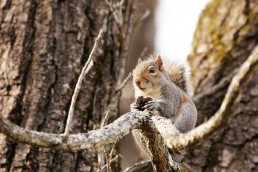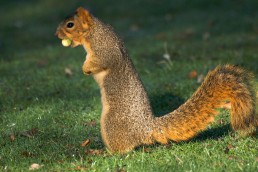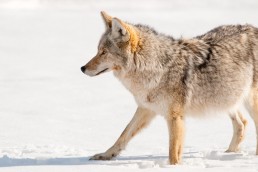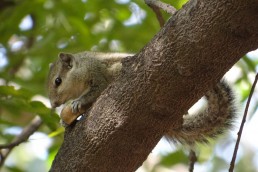Squirrel Season in the Hoosier State
SHARE THIS POST
What can we expect this year?
Indiana squirrel season always excites me! Just when you think you cannot stand another moment of nothing to hunt because turkey season ended in May and deer season does not begin until October, here comes squirrel season.
Some of us that hunt the southern portion of Indiana suffered extreme cold and even snow this spring. Just when trees were budding, a huge cold blast bombarded the southern portion of the state and we lost all the blossoming. Trees are survivors, however, and they started all over again. One thing worth noting is that, even though trees seemed to start over, our mast does not seem to be producing. Of course, this concerns me regarding squirrel population being affected next year (2021). Since squirrels feed mainly on hickory nuts, acorns and dogwood berries, there is major concern of what to expect when we head out to hunt bushy tails this year as well as next. And—did all of Indiana suffer the same weird weather pattern that hit us?
I had the pleasure of corresponding with Matt Broadway, Indiana Small Game Biologist, and he most graciously shared his knowledge with me.
“According to National Oceanic and Atmospheric Administration (NOAA), the statewide average, maximum and minimum temperatures were near average or slightly above average for the period between March-May of 2019. Precipitation was also near average throughout much of the state. That said, the outlook for the squirrel season is good depending on the previous season’s hard mast crop. A 10-year study of squirrel populations in Ohio found that fall squirrel densities were strongly related to the previous year’s mast crop,” states Broadway.
Broadway also mentioned that areas impacted by crop failure, over-winter survival and subsequent year reproduction may have been lower due to poor body condition, causing lower survival rate.
The freeze effect
As I had mentioned earlier, those of us in the southern portion of the state suffered petal loss due to the extreme cold temperatures. When questioning Matt, he agreed that hard freezes could impact our young squirrel population.
“If spring weather happened to delay early fruit production in some regions, juvenile survival might be lower and subsequently effect hunting season (due to) squirrel density. Early-spring fruit production seems to be less important to adult survival,” claims Broadway.
In wrapping up our discussion, I had to ask his opinion as to some areas of the Hoosier state that seem to be suffering a decline in both gray and fox squirrels.
Are you enjoying this post?
You can be among the first to get the latest info on where to go, what to use and how to use it!
“There are certainly a multitude of factors we could consider: region, landscape changes, hunter harvest, weather, mast production, etc. All are important depending on context. If our point of reference is 60 years ago in an area that has now succumbed to suburban sprawl or conversion to agriculture, our answer as to why squirrel populations have declined appears simple. However, in a predominantly forested landscape, it might be less apparent. In this case, something that might be overlooked is how forest stand composition has changed over the years. Clearly, an area once dominated by oak and hickory species that are now past their mast producing prime, and/or have been replaced by silver and red maple, will not support the squirrel densities it once did.
In other instances where forest stand composition has remained unchanged, but perhaps hunting pressure has increased, local squirrel populations may be suppressed if there is not a surplus of squirrels from surrounding landscape to move into the area. Indeed, there is evidence that harvest has negative impacts on subsequent fall densities. If nothing else, this highlights the importance of public land for hunting opportunities even for small game species that may otherwise be regarded as unaffected by harvest,” states Broadway.
The season
Squirrel hunting season dates are August 15, 2020 through January 31, 2021. Keep in mind that if you are hunting squirrels during the deer firearm season (first Friday in November after Nov. 3 through January 31), you must wear hunter orange. Daily bag limit is five and the possession limit is ten squirrels.
Scouting for squirrels may be somewhat more difficult this year and require more diligence to try and find their food sources. I know when the trees do not produce and corn is the main diet, hunting can get tough. However, locate the travel routes to and from the corn field and you may tag out in one location! Keep in mind that squirrels may be nesting close to the food source. Also, water is a necessity, so if you find a waterhole close by, they may frequent it. Look for squirrel tracks on the perimeter of the water.
I do not know what to expect in August. There is one thing I am quite certain of, however: I will be in my woods sitting on a stump and listening at daylight. Hopefully, I will hear a squirrel on the move coming my way, and if I am lucky, a whippoorwill might want to sing out prior to the squirrel’s arrival!
Become a Midwest Outdoors Insider here!
MWO
SHARE THIS POST
Did you enjoy this post?
You can be among the first to get the latest info on where to go, what to use and how to use it!
Vikki Trout
Vikki Trout is an award winning full-time freelance writer and photographer. She learned to hunt and write from her late husband John. Trusting in Christ, she supports herself to this day.



